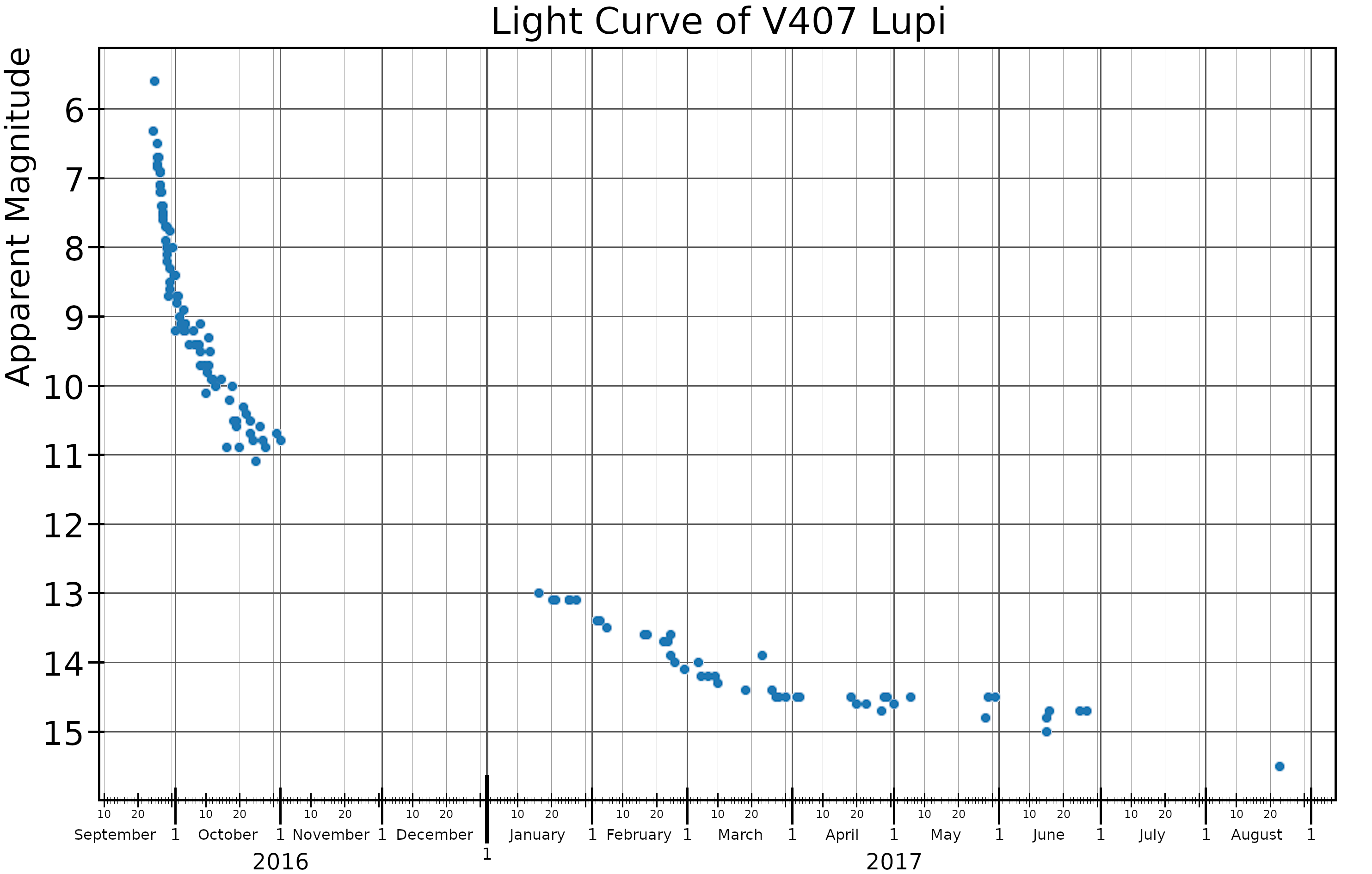ASASSN-16kt on:
[Wikipedia]
[Google]
[Amazon]
 V407 Lupi, also known as Nova Lupi 2016, was a bright
V407 Lupi, also known as Nova Lupi 2016, was a bright
 V407 Lupi, also known as Nova Lupi 2016, was a bright
V407 Lupi, also known as Nova Lupi 2016, was a bright nova
A nova (plural novae or novas) is a transient astronomical event that causes the sudden appearance of a bright, apparently "new" star (hence the name "nova", which is Latin for "new") that slowly fades over weeks or months. Causes of the dramati ...
in the constellation Lupus discovered by All Sky Automated Survey for SuperNovae
The All Sky Automated Survey for SuperNovae (ASAS-SN) is an automated program to search for new supernovae and other astronomical transients, headed by astronomers from the Ohio State University,
including Christopher Kochanek and Krzysztof Stanek. ...
(ASAS-SN) on 24.00 September 2016. At the time of its discovery, it had an apparent visual magnitude
Apparent magnitude () is a measure of the brightness of a star or other astronomical object observed from Earth. An object's apparent magnitude depends on its intrinsic luminosity, its distance from Earth, and any extinction of the object's lig ...
of 9.1. The ASAS-SN team reported that no object at the nova's location brighter than magnitude 17.5 was seen on images taken four days earlier. Wildly incorrect coordinates (in error by many degrees) were published in the announcement telegram, but corrected in a subsequent telegram. It reached a peak brightness of magnitude 5.6, faintly visible to the naked eye, on 25 September 2016.
V407 Lupi declined from its peak brightness very quickly, fading by 2 magnitudes in less than three days. That is one of the most rapid declines in brightness ever seen in a nova. It is therefore classified as a "very fast" nova in the classification scheme of Cecilia Payne-Gaposchkin
Cecilia Payne-Gaposchkin (born Cecilia Helena Payne; – ) was a British-born American astronomer and astrophysicist who proposed in her 1925 doctoral thesis that stars were composed primarily of hydrogen and helium. Her groundbreaking conclus ...
.
All novae are binary stars, with a "donor" star orbiting a white dwarf
A white dwarf is a stellar core remnant composed mostly of electron-degenerate matter. A white dwarf is very dense: its mass is comparable to the Sun's, while its volume is comparable to the Earth's. A white dwarf's faint luminosity comes fro ...
. The two stars are so close to each other that matter is transferred from the donor to the white dwarf. Observations by the satellite TESS Tess or TESS may refer to:
Music
* Tess (band), a Spanish pop band active from 2000 to 2005
* TESS (musician), a UK musician
Film and theatre
* ''Tess'' (1979 film), a 1979 film adaptation of '' Tess of the d'Urbervilles''
* ''Tess'' (2016 film) ...
detected a variation in the light curve of V407 Lupi indicating an orbital period for the binary system of 3.513 days; it was previously thought to be 3.573 hours, but this has since been disproven. A second periodicity in the light curve was also detected by the Chandra X-ray Observatory
The Chandra X-ray Observatory (CXO), previously known as the Advanced X-ray Astrophysics Facility (AXAF), is a Flagship-class space telescope launched aboard the during STS-93 by NASA on July 23, 1999. Chandra is sensitive to X-ray sources 1 ...
and has a period of , which appears to be the rotation period of the white dwarf. The very rapid decline from peak brightness indicates that the mass of the white dwarf is ≥ 1.25 , not far below the Chandrasekhar limit
The Chandrasekhar limit () is the maximum mass of a stable white dwarf star. The currently accepted value of the Chandrasekhar limit is about ().
White dwarfs resist gravitational collapse primarily through electron degeneracy pressure, compared ...
for white dwarf masses. The system is probably an intermediate polar nova.
References
Novae Lupus (constellation) 20160924 Lupi, V407 {{var-star-stub